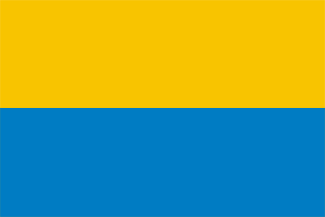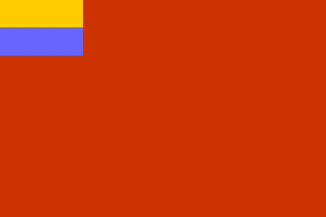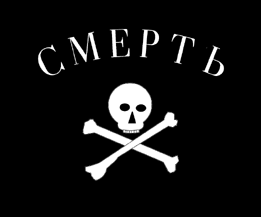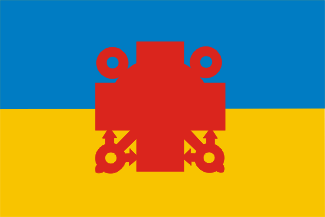 image by Jaume Olle, 31 August 2001
image by Jaume Olle, 31 August 2001
Last modified: 2022-03-19 by rob raeside
Keywords: ukraine | hutsul | verkhovyna |
Links: FOTW homepage |
search |
disclaimer and copyright |
write us |
mirrors
20 November 1917 Flag image by Jaume Olle, 31 August 2001
image by Jaume Olle, 31 August 2001
See also:
The first opportunity for Ukrainians to adopt the blue and yellow as a national flag came with the break up of the Austrian and Russian empires as a result of World War I. The Ukrainian National Republic (UNR) was proclaimed on 20 November 1917. This was planned as a republic within a (future) Russian federation. However, because of the Bolshevik takeover in Russia and the war launched into Ukraine, independence was declared 22 January 1918. On the same day, the national flag of yellow over light blue was adopted 22 March 1918 . A naval ensign with a trident had been adopted a few days earlier, on 18 January 1918 [Encyclopedia Ukraine].
On 29 April 1918, a coup overthrew the UNR government. General
Pavlo Skoropadsky set up the 'Hetmanate of Ukraine' ('Hetman' is
an old title used by certain military leaders). The flag was now
changed to light blue over yellow.
Jan Oskar Engene, 7 September 1996
State flag adopted 22 March, 1918, existed until May 1918.
Victor Lomantsov, 1 July 2001
Historical Facts: After the Russian
revolution and the creation of the provisional government (March
1917) the Ukrainian nationalists assumed the control of many
institutions and on 3 April they constituted the National Council
or Central Rada, while Bolshevik groups created the Soviets of
Soldiers and Workers. The Rada requested full autonomy on 26
April. On 13 July, with the nationalists growing stronger and
stronger, it was proclaimed the autonomous territory of Ukraine
within Russia and a provisional government was formed. The
Russian government sent delegates to negotiate the future status,
but no agreement had been reached when the Bolsheviks took the
power. The Rada refused to recognize the Soviet government and on
20 November 1917 it was proclaimed the Ukrainian Peoples Republic
with the governments of Kiev, Podolia, Volinia,Chernigov,
Poltava, Jarkov, Yekaterinoslav, Jerson and Tauride. The yellow
and blue flag was adopted on 29 December 1917.
On 17 December Lenin recognized the Republic. In December France
and in January England also recognized it. Nevertheless the
Ukrainian government declared that its aim was a federation of
republics emerged from the ancient Russian empire.
The Bolsheviks of the Soviet Republic of Ukraine occupied Kiev (2
February) thanks to the fact that many Ukrainian forces changed
sides and other refused to fight. The government of the Rada,
chaired by Binechenko, that was negotiating a separate peace with
the central Powers, was arrested. The Ukrainian forces
concentrated in Pechek, South of Kiev, and the government of the
Rada moved to Jitomir under the presidency of Golubovich. On 9
February 1918 they signed the peace separately with Germany and
Austria: Ukraine kept its frontiers and got the territory of
Kholm. The German armies broke the ceasefire with Russia on 18
February and entered in Ukraine on 19 February. Golubovich, who
was in Jitomir in adesperate situation due to the unstoppable
Bolshevik advance, requested help from Germany (19 February) .
The German troops crossed the Dnieper on 1 March and advanced in
all fronts and headed to Kiev that was occupied the following
day. On 3 March Russia signed an armistice (that leaded to the
peace of Brest-Litovsk on 8 March) and the combats stopped in
Russian territory but not in Ukraine. The Treaty of Brest Litovsk
assigned to Ukraine a part of Belorussia (8 March), that however
lost part of Kholm. On 12 March practically all Ukraine was under
Austrian or German control.
The President of the Rada, Golubovich, collaborated with the
Germans but they favored the landowners and conservative classes
while the government was socialdemocratic. As the anti-German
agitation was increasing and the Rada was expressing more and
more opposition to the occupation regime, the German Army
performed a coup d'état. On 29 April the Parliament or Rada
elected Michael Hrushewsky as first president of the Republic.
The following day the German forces, with the collaboration of
the cossaks of the Hetman Skoropadsky, performed a coup d'état.
Hrushevsky and other members of the Rada were jailed. It was
proclaimed the martial law. At the head of the government was put
the Hetman Paulov Skoropadsky.
Led by the anarchist Nestor Makhno. In the area of Guliay-Pole it
was created an 'anarchist state' (sic!). Makhno fought against
the Germans, against the white armies (on the side of the Red
Army), and against the Bolsheviks. The flags of the 'makhnovtzy'
were black with inscripions "Anarchy is the mother of
order" [Anarkhiya - mat' poriadka] and other inscriptions,
or plain black or red-black.
Soviet Republic of Ukraine (December 1917): On
23 December the Bolsheviks took Jarkov in the Eastern Ukraine.
They also controlled Shmerinka in the West. The first Congress of
all the Soviets of Ukraine gathered in Jarkov on 12 December 1917
and decided the establishment of the formally proclaimed Soviet
Republic on 25 December (Ukrainian Peoples Republic of the
Soviets of Workers and Peasants, or Soviet Federal Republic of
Ukraine or Soviet Peoples Republic of Ukraine) that had as its
capital Jarkov. The Soviet republic encompassed theoretically all
the Soviets of Ukraine, each one having established their own
republic. It subsisted until May 1918. It used red flag with the
national flag in the canton, adopted at the beginning of January
1918. In this month Yekaterisnoslav was occupied. In February the
Bolshevik forces entered in Kiev, but the arrival of German
forces (March) forced them to vacate it, losing practically all
Ukraine. The Republic of Donetzk-Krivorog was established
simultaneously with capital in Jarkov, probably as one of the
constituent subrepublics.
Jaume Olle, 31 August 2001
 image by Jaume Olle, 31 August 2001
image by Jaume Olle, 31 August 2001
On 20 November 1917 it was proclaimed the the Peoples Republic
of Ukraine's flag used is yellow over light blue adopted oficilly
29 December 1917. Arms were adopted only in 14 March 1919.
Jaume Olle, 31 August 2001
 image by Jaume Olle, 31 August 2001
image by Jaume Olle, 31 August 2001
On 25 December 1917 , the Bolsheviks at Kharkov proclaimed the
Soviet Republic (Ukraine Peoples Republic of the Soviets of
Workers and Peasants). Both governments disputed territory until
that the german invasion ended the Soviet government in March
1918.
Jaume Olle, 31 August 2001
 image by Jaume Olle, 26 August 2001
image by Jaume Olle, 26 August 2001
 image by Jaume Olle, 26 August 2001
image by Jaume Olle, 26 August 2001
Note: there are spelling mistakes in this image
In those years the Revolutionary Insurgent Army led by Makhno
operated in Ukraine. Several black flags were used and the this
one is only a exemple of this kind of flags.
Jaume Olle, 31 August 2001
The text on this "death's head" flag reads
"smert'" (death) . I understand that this is an example
of various black flags. I have a book on Air Force markings
which says the Ukrainian AF in this era often used "skull
and bone" markings on their aircraft (I believe it was Y
skull & bones on a W roundel with a B- border).
Dean R. Mc Gee, 26 August 2001
Gary wrote: "In the second flag with the skull
and cross bones ("smert'" death) the last word is with
a "P", but it should be with an "L" according
to my Ukrainian wife."
It is obviously so. The last line, "trudovomu
lyudu" would then mean "for the working
people." The rest of it transliterates as
(approximately) "Smert' vsim, khto [Death to all who] na
pirishkodi dobut'ya vshchnost!" whatever that may
mean.
Joe McMillan, 11 Febuary 2003
Many grammatic mistakes in small phrase:
Smert vsim - Death to all
khto na pirishkodi - who prevents
dobuttya vil`nosti - receiving of freedom
trudovomu lyudu - for working people
You may see photo of this banner on my site at <www.vexillographia.ru>.
Victor Lomantsov, 11 Febuary 2003
I take it that the second letter in the last word of the
second line below the skull should be I (Ukrainian I with dot,
not the other Cyrillic i that looks like a backward N), followed
by "L." At present, the image shows the letter
transliterated as "shch." And the last letter of
that word should be the same Ukrainian dotted I, not an
exclamation mark. Any other misspellings?
Joe McMillan, 11 Febuary 2003
On November 1918 the National Council established its control
in Jasina forming a government known as Republic of Hutsul. The
flag purportedly used was the blue over yellow of Ukraine. By mid
June 1919 the region was occupied by the Rumanians and the
Republic was dissolved.
Jaume Olle, 31 August 2001
In November 1918 the National Council established its control
in Uzghorod forming a government known as Republic of Verkhovyna,
that later joined other local Councils to create the government
of the National Council of the Subcarpatian Russia or
Podkarpatska Rus that negotiated and obtained its union with
Czechoslovakia as an autonomous province (15 March). The flag
used was the blue over yellow of Ukraine. The union with autonomy
was recognized by the Treaty of Saint Germain of 10 September
1919.
Jaume Olle, 31 August 2001
Small ethnic groups within the Austro-Hungarian Empire created
their national Councils in 1918. With the collapse of the
Austro-Hungarian front these national Councils proclaimed various
republics: Baranya, Eastern Slovakia, Hutsul, Przemysl, Lemko...
Information on thosr republics can be found in C.A. Maccartney,
Hungary and Her Successors: The Treaty of Trianon and Its
Consequences, 1919-1937 (Oxford, 1937); and Ladislav Tajtak,
Narodno-demokratic revolucia na vychodnom Slovensku v roku 1918
(Bratislava, 1972).
The Ukrainian National Council of Przemysl proclaimed in November
1918 used the blue over yellow flag. Few weeks later it joined
the Republic of Western Ukraine that at the same time joined the
Peoples Republic of Ukraine, but little after it was occupied by
Poland.
Jaume Olle, 31 August 2001
The eastern region of the Lemkos identified itself with
Ukraine but the western region had more links with Russia. In the
eastern region an assembly was held at the beginning of November
1918, summoned by the Catholic Church, and chaired by
pro-Ukrainians. The Assembly proclaimed the Republic of Komancza,
whose flag is unknown, but as the goal was union with the Peoples
Republic of Western Ukraine proclaimed only some days before in
Lemberg (Lvov), is can be supposed that it used the blue over
yellow flag. On 23 January 1919 the Republic was occupied by the
Poles.
Jaume Olle, 31 August 2001
In the western Lemko region Councils were formed in several
towns (27 November 1918). In Gladyszow it was created the Rusyn
National Council (Ruska Rada) that rejected the union with
Western Ukraine and declared their intention of uniting the
territory with Russia. On 5 December 1918 the National Council
grouping all local councils was established in Florynka. This
body decided the establishment of self-government (Republic of
Lemkivshchyna) and the creation of an executive Council chaired
by Rev. Mykhal Iurchakevych, with the presidency of the Ruska
Rada in the person of Dr. Iaroslav Kachmarchyk. It was created a
national guard and the civil administration was organized. The
Poles supported this initiative in the hope that the new republic
would collaborate against Westerm Ukraine and thus allowed the
establishment of the government in Grybow, giving weapons to the
national guard of the republic. On 13 December the leaders of the
Republic nevertheless declared its desire of joining the Greater
Russia. But since Russia was torn by civil war, the authorities
sought other solutions. In January it was negotiated the creation
of a National Council for the administration of all the region of
the Rhutenian Carpathians with the aim of a union with
Czechoslovakia. These decisions were approved in March in an
Assembly in Florynka and the delegates sent to the Peace
Conference of Paris were authorized to accept the project, that
was fulfilled in the memorandum signed in Paris 20 April. The
autonomous State of Carpathia-Rus would encompass the region of
Lemko, the region of Presov, and the Subcarpathian Russia. Poland
was committed itself not to interfere but little after arrested
Rev. Iurchakevych by his pro-Czech activities. On 8 May 1919 the
Rusyn South of the Carpathians declared themselves in Uzhhorod in
favor of the union with Czechoslovakia but the union of the
region of Lemko was considered problematic because the question
of its limits was not solved and thus in June 1919 the Peace
Conference authorized Poland to occupy temporarily Galitzia but
at the disposal of the Allies. The Lemkos then returned to the
idea of a union with Russia that was involved in civil war. On 12
March 1920 it was held the second Lemko National Congress that
created formally the government of the Republic with Dr. Iaroslav
Kachmarchyk as President and Rev. Dmytro Khyliak as Minister of
Foreign Affairs. The Congress authorized the government to
negotiate with Czechoslovakia. But Czechoslovakia and Poland had
established good relations and the issue of Lemko was disturbing
the process. Around the end of March the Poles arrested
Kachmarchyk and other leaders, under accusation of separatism.
Judged in June they were acquitted, but the Republic was
definitely dissolved in January 1921. In March 1923 Galitzia was
recognized as a Polish possession with no autonomy for its Rusyn
or Ukrainian inhabitants.
Jaume Olle, 31 August 2001
 image by Jaume Olle, 31 August 2001
image by Jaume Olle, 31 August 2001
National Red Cross (only in Montells [mjm94]), Hospoitals used the white
flag with red cross (International red cross organization).
Jaume Olle, 31 August 2001
 image
by Jaume Olle, 31 August 2001
image
by Jaume Olle, 31 August 2001
President of the Ukranian Red Cross (only in Montells [mjm94]).
Jaume Olle, 31 August 2001
 image by Jaume Olle, 31 August 2001
image by Jaume Olle, 31 August 2001
Rescue Society (only in Montells [mjm94]).
Jaume Olle, 31 August 2001